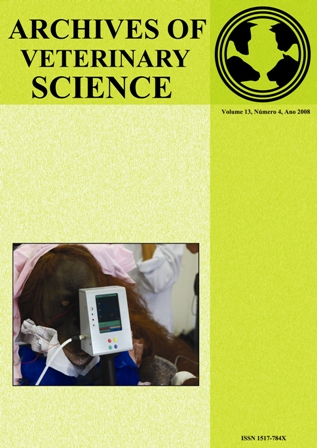COMPARAÇÃO DE DIFERENTES PROTOCOLOS PARA A SINCRONIZAÇÃO DE ESTRO E INSEMINAÇÃO ARTIFICIAL EM TEMPO FIXO EM VACAS DA RAÇA NELORE EM ANESTRO PÓS-PARTO
DOI:
https://doi.org/10.5380/avs.v13i4.15270Palavras-chave:
acetato de medroxiprogesterona, cipionato de estradiol, bovinosResumo
Neste estudo comparou-se diferentes métodos de sincronização de estro em 139 vacas da raça Nelore, em novembro de 2006 no município de Arapoti-PR. Foram utilizados quatro protocolos de sincronização de estro. No primeiro grupo (G1), foi utilizado pessário vaginal de poliuretano, impregnada com 360 mg de acetato de medroxiprogesterona (MAP) e 2 mg de Benzoato de Estradiol (BE) (=dia 0). Após a remoção (=dia 8), foi administrado 150 µg de cloprostenol, na submucosa vulvar (para todos os grupos) e 1 mg de cipionato de estradiol (ecp). No grupo dois (G2) foram utilizados pessários vaginais idênticos aos usados no G1. Na remoção (dia 8) foi administrado 0,75 µg de cloprostenol e 1 mg de cipionato de estradiol. No grupo três (G3), foi utilizado dispositivo intravaginal (sob a forma de Y) reaproveitado e impregnado com 360 mg de MAP e 2 mg de BE. Após 8 dias era removido e administrava-se 150 µg de cloprostenol e 1 mg de cipionato de estradiol. No grupo quatro (G4), foi utilizado identico dispositivo intravaginal ao usado no G3 e após removido(dia 8), aplicava-se 0,75 µg de cloprostenol sem o ecp. Para os grupos G1, G2, G3 a inseminação artificial (IA) foi realizada em tempo fixo às 56 horas após a retirada do pessário vaginal, sem a observação de estro. No G4 a IA era realizada 12 horas após a observação visual de estro. O diagnóstico de gestação foi efetuado por palpação retal após 60 dias. Concluiu-se que os diferentes protocolos de sincronização de estro utilizados não influenciaram a taxa de prenhez.
Downloads
Como Citar
Edição
Seção
Licença
Autores que publicam nesta revista concordam com os seguintes termos:
- Autores mantém os direitos autorais e concedem à revista o direito de primeira publicação, com o trabalho simultaneamente licenciado sob a Creative Commons - Atribuição 4.0 Internacional que permite o compartilhamento do trabalho com reconhecimento da autoria e publicação inicial nesta revista.
- Autores têm autorização para assumir contratos adicionais separadamente, para distribuição não-exclusiva da versão do trabalho publicada nesta revista (ex.: publicar em repositório institucional ou como capítulo de livro), com reconhecimento de autoria e publicação inicial nesta revista.
- Autores têm permissão e são estimulados a publicar e distribuir seu trabalho online (ex.: em repositórios institucionais ou na sua página pessoal) a qualquer ponto antes ou durante o processo editorial, já que isso pode gerar alterações produtivas, bem como aumentar o impacto e a citação do trabalho publicado.














